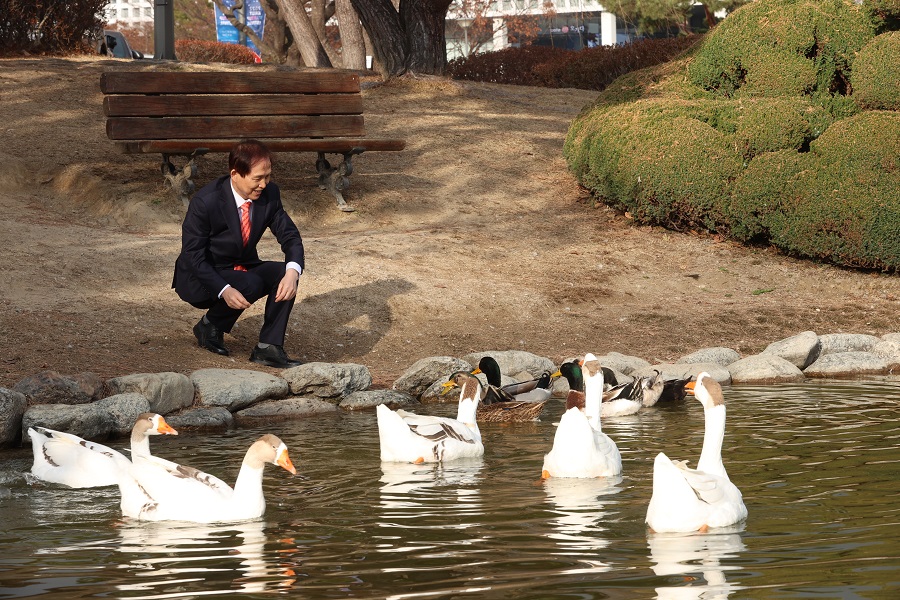people
In October of this year, KAIST signed an 'Agreement for the Training Program for AI Semiconductor Designers' with Samsung Electronics, to conduct joint research and actively nurture master's and doctorate researchers in the field of Semiconductors designed exclusively for AI devices. To celebrate this commemorative agreement for cooperation bound for mutual success, Samsung Electronics gifted a set of 5 ducks to KAIST.
The Duck Pond and the Geese have been representing KAIST as famous mascots.

It all started back in 2000, when the incumbent President, Professor Kwang Hyung Lee served was then a professor at the Department of Bio and Brain Engineering, he first picked up a pack of ducks from Yuseong Market and started taking care of it on campus around the Carillon pond. While the ducks came and went, eventually being replaced with a pack of geese over the time, for more than 20 years, the pack of feathery KAISTians stole the eyes of the passersby and were loved by both the on-campus members and the visitors, alike.
The representative of the Samsung Electronics said that the pack of ducks comprising of a new breed contains the message of SEC that it hopes that the PIM semiconductor technology will grow to become the super-gap technology that would turn heads and grab attention of the world as the mascot of Korea's technological prowess under the combined care of KAIST and SEC.
Would the ducks find KAIST likable? We will keep you informed of how they are doing!
-
__intro__ KAIST Develops AI That Automatically Designs Optimal Drug Candidates for Cancer-Targeting Mutations
< (From left) Ph.D candidate Wonho Zhung, Ph.D cadidate Joongwon Lee , Prof. Woo Young Kim , Ph.D candidate Jisu Seo > Traditional drug development methods involve identifying a target protin (e.g., a cancer cell receptor) that causes disease, and then searching through countless molecular candidates (potential drugs) that could bind to that protein and block its function. This process is costly, time-consuming, and has a low success rate. KAIST researchers have developed an AI model th
2025-08-12 -
event 'Team Atlanta', in which KAIST Professor Insu Yun research team participated, won the DARPA AI Cyber Challenge in the US, with a prize of 5.5 billion KRW
<Photo1. Group Photo of Team Atlanta> Team Atlanta, led by Professor Insu Yun of the Department of Electrical and Electronic Engineering at KAIST and Tae-soo Kim, an executive from Samsung Research, along with researchers from POSTECH and Georgia Tech, won the final championship at the AI Cyber Challenge (AIxCC) hosted by the Defense Advanced Research Projects Agency (DARPA). The final was held at the world's largest hacking conference, DEF CON 33, in Las Vegas on August 8 (local time)
2025-08-10 -
event Prof. Seungbum Koo’s Team Receives Clinical Biomechanics Award at the 30th International Society of Biomechanics Conference
<(From Left) Ph.D candidate Jeongseok Oh from KAIST, Dr. Seungwoo Yoon from KAIST, Prof.Joon-Ho Wang from Samsung Medical Center, Prof.Seungbum Koo from KAIST> Professor Seungbum Koo’s research team received the Clinical Biomechanics Award at the 30th International Society of Biomechanics (ISB) Conference, held in July 2025 in Stockholm, Sweden. The Plenary Lecture was delivered by first author and Ph.D. candidate Jeongseok Oh. This research was conducted in collaboration with P
2025-08-10 -
event KAIST’s Wearable Robot Design Wins ‘2025 Red Dot Award Best of the Best’
<Professor Hyunjoon Park, M.S candidate Eun-ju Kang, Prospective M.S candidate Jae-seong Kim, undergraduate student Min-su Kim> A team led by Professor Hyunjoon Park from the Department of Industrial Design won the ‘Best of the Best’ award at the 2025 Red Dot Design Awards, one of the world's top three design awards, for their 'Angel Robotics WSF1 VISION Concept.' The design for the next-generation wearable robot for people with paraplegia successfully implements functional
2025-08-09 -
research Unlocking New Potential for Natural Gas–Based Bioplastic Production
<(From Left)Jaewook Myung from KAIST, Sunho Park from KAIST, Dr. Chungheon Shin from Stanford University, Prof. Craig S. Criddle from Stanford University > KAIST announced that a research team led by Professor Jaewook Myung from the Department of Civil and Environmental Engineering, in collaboration with Stanford University, has identified how ethane (C2H6)—a major constituent of natural gas—affects the core metabolic pathways of the obligate methanotroph Methylosinus tric
2025-08-07